
Latvia, officially the Republic of Latvia, is a country in the Baltic region of Northern Europe. It is one of the three Baltic states, along with Estonia to the north and Lithuania to the south. It borders Russia to the east and Belarus to the southeast, and shares a maritime border with Sweden to the west. Latvia covers an area of 64,589 km2 (24,938 sq mi), with a population of 1.9 million. The country has a temperate seasonal climate. Its capital and largest city is Riga. Latvians belong to the ethnolinguistic group of the Balts and speak Latvian. Russians are the most prominent minority in the country, at almost a quarter of the population; 37.7% of the population speak Russian as their native tongue.

The Republics of the Union of Soviet Socialist Republics or the Union Republics were national-based administrative units of the Union of Soviet Socialist Republics (USSR). The Soviet Union was formed in 1922 by a treaty between the Soviet republics of Byelorussia, Russian SFSR (RSFSR), Transcaucasian Federation, and Ukraine, by which they became its constituent republics of the Union of Soviet Socialist Republics.

The Baltic states or the Baltic countries is a geopolitical term encompassing Estonia, Latvia, and Lithuania. All three countries are members of NATO, the European Union, the Eurozone, Council of Europe, and the OECD. The three sovereign states on the eastern coast of the Baltic Sea are sometimes referred to as the "Baltic nations", less often and in historical circumstances also as the "Baltic republics", the "Baltic lands", or simply the Baltics.

The Singing Revolution was a series of events from 1987 to 1991 that led to the restoration of independence of the three Soviet-occupied Baltic countries of Estonia, Latvia, and Lithuania at the end of the Cold War. The term was coined by an Estonian activist and artist, Heinz Valk, in an article published a week after the 10–11 June 1988 spontaneous mass evening singing demonstrations at the Tallinn Song Festival Grounds.
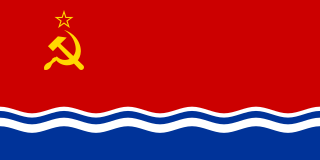
The Latvian Soviet Socialist Republic, also known as Soviet Latvia or simply Latvia, was de facto one of the constituent republics of the Soviet Union between 1940–1941 and 1944–1990.
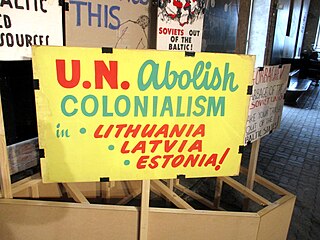
The occupation of the Baltic states was a period of annexation of Estonia, Latvia and Lithuania begun by the Soviet Union in 1940, continued for three years by Nazi Germany after it invaded the Soviet Union in 1941, and finally resumed by the Soviet Union until its dissolution in 1991.

Kārlis Augusts Vilhelms Ulmanis was a Latvian politician and a dictator. He was one of the most prominent Latvian politicians of pre-World War II Latvia during the Interwar period of independence from November 1918 to June 1940 and served as the country's first prime minister.
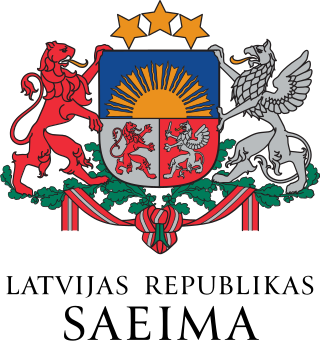
The Saeima is the parliament of the Republic of Latvia. It is a unicameral parliament consisting of 100 members who are elected by proportional representation, with seats allocated to political parties which gain at least 5% of the popular vote. Elections are scheduled to be held once every four years, normally on the first Saturday of October. The most recent elections were held in October 2022.

The Soviet westward offensive of 1918–1919 was part of the campaign by Soviet Russia into areas abandoned by the Ober Ost garrisons that were being withdrawn to Germany following that country's defeat in World War I. The initially successful offensive against the Republic of Estonia ignited the Estonian War of Independence which ended with the Soviet recognition of Estonia. Similarly, the campaigns against the Republic of Latvia and Republic of Lithuania ultimately failed, resulting in the Latvian–Soviet Peace Treaty and Soviet–Lithuanian Peace Treaty respectively. In Belarus, the Belarusian People's Republic was conquered and the Socialist Soviet Republic of Byelorussia proclaimed.
Territorial changes of the Baltic states refers to the redrawing of borders of Lithuania, Latvia and Estonia after 1940. The three republics, formerly autonomous regions within the former Russian Empire and before that of former Polish–Lithuanian Commonwealth and as provinces of the Swedish Empire, gained independence in the aftermath of World War I and the Russian Revolution of 1917. After a two-front independence war fought against both Bolshevist Russian and Baltic German nationalist forces, the countries concluded peace and border treaties with Soviet Russia in 1920. However, with World War II and the occupation and annexation of these republics into the Soviet Union twenty years after their independence, certain territorial changes were made in favour of the Russian SFSR. This has been the source of political tensions after they regained their independence with the dissolution of the Soviet Union. Some of the disputes remain unresolved.
In Latvia, Russians have been the largest ethnic minority in the country for the last two centuries. The number of Russians in Latvia more than quadrupled during the Soviet occupation of Latvia when the size of the community grew from 8.8% of the total population in 1935 (206,499) to 34.0% in 1989 (905,515). It started to decrease in size again after Latvia regained independence in 1991 falling to 23.4% at the beginning of 2024.

The history of the Jews in Latvia dates back to the first Jewish colony established in Piltene in 1571. Jews contributed to Latvia's development until the Northern War (1700–1721), which decimated Latvia's population. The Jewish community reestablished itself in the 18th century, mainly through an influx from Prussia, and came to play a principal role in the economic life of Latvia.
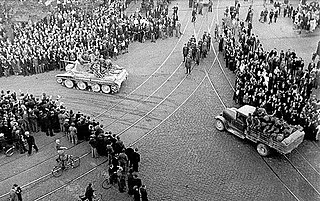
The Soviet occupation of Latvia in 1940 refers to the military occupation of the Republic of Latvia by the Soviet Union under the provisions of the 1939 Molotov–Ribbentrop Pact with Nazi Germany and its Secret Additional Protocol signed in August 1939. The occupation took place according to the European Court of Human Rights, the Government of Latvia, the United States Department of State, and the European Union. In 1989, the USSR also condemned the 1939 secret protocol between Nazi Germany and herself that had led to the invasion and occupation of the three Baltic countries, including Latvia.

Latvia–Russia relations are the bilateral foreign relations between Latvia and Russia. Latvia has an embassy in Moscow. The Russian Federation has an embassy in Riga.

After the dissolution of the Soviet Union (USSR) in December 1991, about 25 million ethnic Russians in post-Soviet states found themselves living outside of Russia.
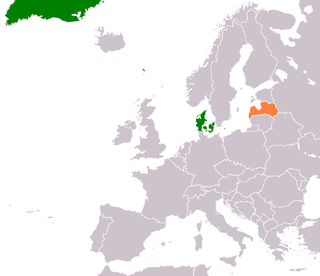
Denmark–Latvia relations refers to the historical and current diplomatic relations between Denmark and Latvia. Denmark has an embassy in Riga and Latvia has an embassy in Copenhagen.

Captain Richard Gustav Borgelin was a Danish officer and company commander of the Danish-Baltic Auxiliary Corps (DBAC) in 1919 during the Estonian and Latvian War of Independence.

The State Police of Latvia is the national police service and one of the national law enforcement agencies of the Republic of Latvia. It is subordinate to the Ministry of the Interior. The agency is divided into five Regional Administrations. Since the 13th of October 2020, the Chief of the State Police is General Armands Ruks.

Soviet involvement in regime change entailed both overt and covert actions aimed at altering, replacing, or preserving foreign governments. In the 1920s, the nascent Soviet Union intervened in multiple governments primarily in Asia, acquiring the territory of Tuva and making Mongolia into a satellite state. During World War II, the Soviet Union helped overthrow many puppet regimes of Nazi Germany and the Empire of Japan, including in East Asia and much of Europe. Soviet forces were also instrumental in ending the rule of Adolf Hitler over Germany.
















